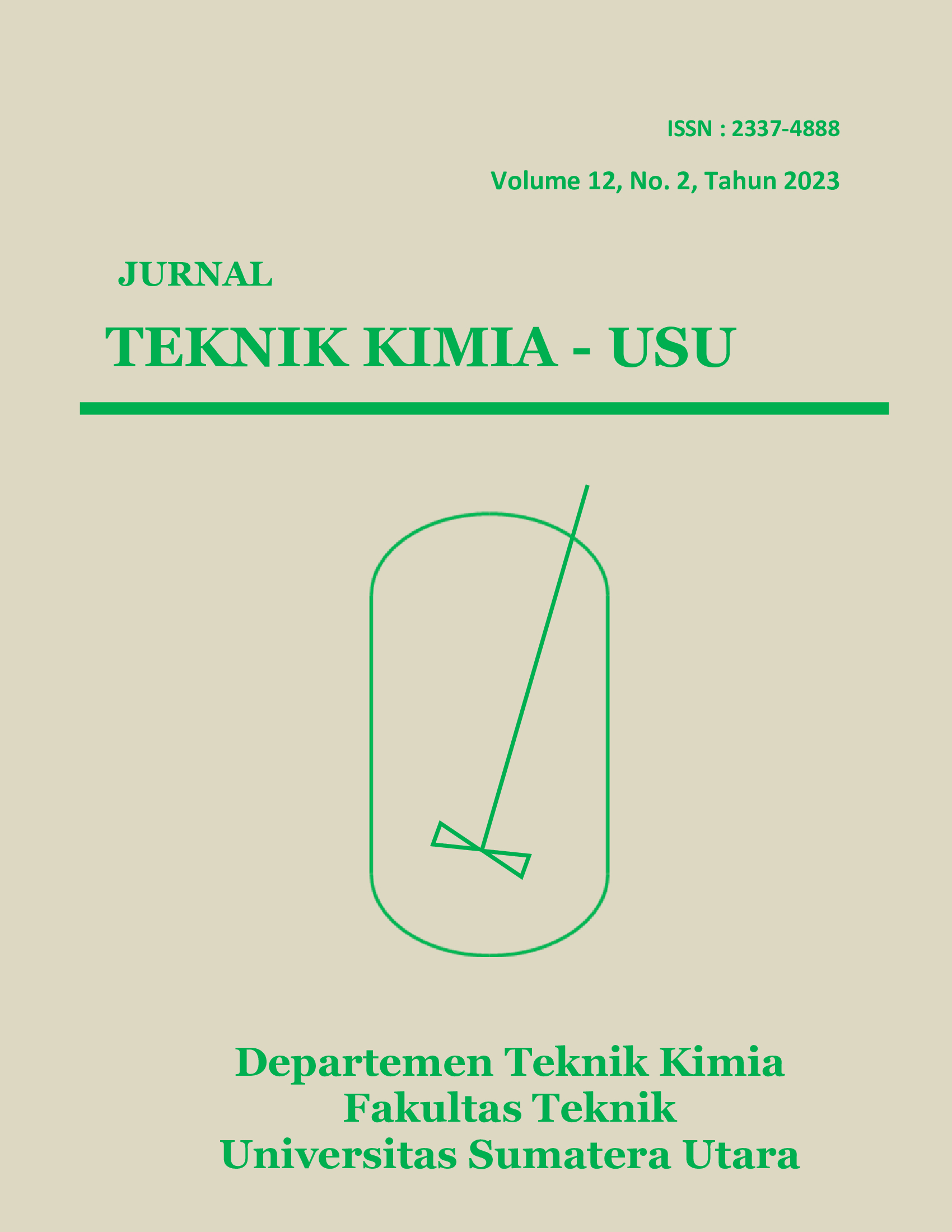Analisis Kuat Geser Perekat Alami Berbahan Soy Protein Isolate dengan Variasi Natrium Sulfit dan Asam Oksalat
DOI:
https://doi.org/10.32734/jtk.v12i2.11929Keywords:
bioadhesive, oxalic acid, shear strength, soy protein isolate, sodium sulphiteAbstract
Along with the technology development, the use of bioadhesive for medical purpose is a common thing. The purpose of this bioadhesive is to give support for the medication because it can be decomposed and ejected by human body. This research aims to analyze the quality of bioadhesive made of soy protein isolate (SPI) as main ingredient. SPI has food-grade level of safety thus it is safe for human body. This bioadhesive is made by two main processes: denaturation of protein dan acid crosslinking. The processes are done under condition of 55 °C dan atmospheric pressure for 30 minutes dan 10 minutes. Shear strength, wet shear strength, viscosity, solid content, and fourier transform infrared spectroscopy (FTIR) analysis were done to find out the impact of oxalic acid addition. The best shear strength result obtained was 1.9051 MPa and wet shear strength result was 1.6093 MPa.
Downloads
References
S. Ebnesajjad and A. H. Landrock, Adhesives Technology Handbook. 2014.
I. N. Eskani, R. Widiastuti, N. N. Lathifah, “Karakterisasi perekat alami dari tumbuhan untuk industri kerajinan,†Seminar Nasional Teknologi Industri Hijau, no. 2, 2017, pp. 295–300, 2017.
Vincent, B. P. Pancasakti, Budhijanto, “Pengaruh penambahan minyak kelapa murni terhadap sifat perekat berbahan dasar tepung tapioka,†Jurnal Teknik Kimia USU, vol. 11, no. 1, pp. 1–7, 2022
A. R. A. Santosa, A. S. Zain, B. P. Pancasakti, Budhijanto, “Analisis kuat tarik dan umur perekat poliamida berbasis gelatin dan asam adipat dengan variasi jumlah minyak sawit sebagai pemlastis,†Jurnal Teknik Kimia USU, vol. 11, no. 2, pp. 64–71, 2022.
S. Li et al., “Injectable click chemistry-based bioadhesives for accelerated wound closure,†Acta Biomater, vol. 110, pp. 95–104, 2020, doi: 10.1016/j.actbio.2020.04.004.
K. Nishinari, Y. Fang, S. Guo, and G. O. Phillips, “Soy proteins: A review on composition, aggregation and emulsification,†Food Hydrocolloids, vol. 39. pp. 301–318, Aug. 2014. doi: 10.1016/j.foodhyd.2014.01.013.
H. Wang, L. A. Johnson, and T. Wang, “Preparation of soy protein concentrate and isolate from extruded-expelled soybean meals,†Journal of the American Oil Chemists' Society, 81, 713-717, 2004.
P. Singh, R. Kumar, S. N. Sabapathy, and A. S. Bawa, “Functional and edible uses of soy protein productsâ€, Comprehensive reviews in food science and food safety, 7(1), 14-28, 2008.
M. Schmid, T. K. Prinz, A. Stäbler, and S. Sängerlaub, “Effect of sodium sulfite, sodium dodecyl sulfate, and urea on the molecular interactions and properties of whey protein isolate-based films,†Front Chem, vol. 5, no. JAN, pp. 1–15, 2017, doi: 10.3389/fchem.2016.00049.
J. L. Bailey and R. D. Cole, “Studies on the reaction of sulfite with proteins,†J Biol Chem, vol. 234, no. 7, pp. 1733–1739, 1959, doi: 10.1016/s0021-9258(18)69917-x.
P. Zheng, Q. Lin, F. Li, Y. Ou, and N. Chen, “Development and characterization of a defatted soy flour-based bio-adhesive crosslinked by 1,2,3,4-butanetetracarboxylic acid,†Int J Adhes Adhes, vol. 78, no. June, pp. 148–154, 2017, doi: 10.1016/j.ijadhadh.2017.06.016.
E. Saldıvar and E. Vivaldo, Handbook of Polymer Synthesis, Characterization, and Processing, Wiley. 2013.
D. E. Packham, Handbook of Adhesion Promoters, 2nd ed. John Wiley, 2005.
Y. Zeng et al., “Soy protein-based adhesive with superior bonding strength and water resistance by designing densely crosslinking networks,†Eur Polym J, vol. 142, 2021, doi: 10.1016/j.eurpolymj.2020.110128.
R. B. Bird, W. E. Stewart, and E. N. Lightfoot, Transport Phenomena, 2nd ed. New York: John Wiley & Sons, Inc., 2002.
A. Lukmana, “Denaturasi Protein,†Jurnal Kimia dan Kemasan. p. 1, 2011. doi: 10.24817/jkk.v0i0.4853.
C. Liu, Y. Zhang, X. Li, J. Luo, Q. Gao, and J. Li, “A high-performance bio-adhesive derived from soy protein isolate and condensed tannins,†RSC Adv, vol. 7, no. 34, pp. 21226–21233, 2017, doi: 10.1039/C7RA01210A.
A. Gide, “The effect of denaturation on the viscosity of protein systems,â€Angewandte Chemie International Edition, 6(11), 951–952., pp. 5–24, 1967.
Downloads
Published
Issue
Section
License
Copyright (c) 2023 Jurnal Teknik Kimia USU

This work is licensed under a Creative Commons Attribution-ShareAlike 4.0 International License.

















